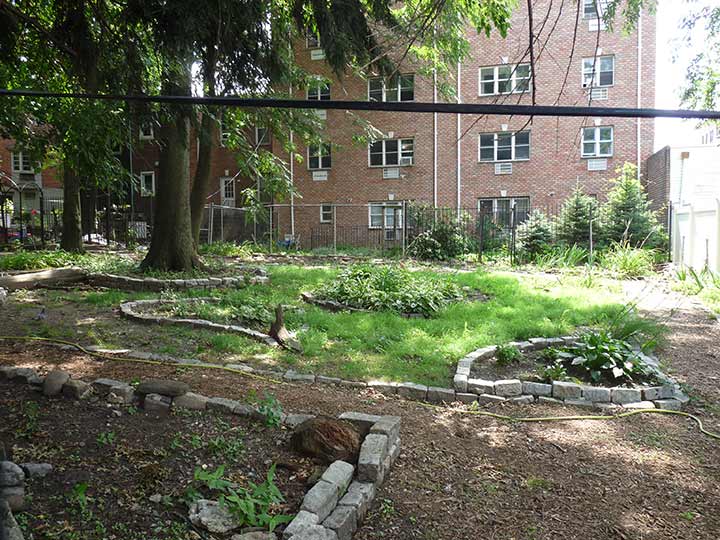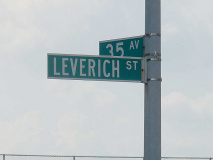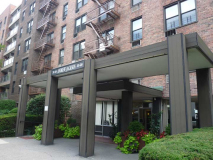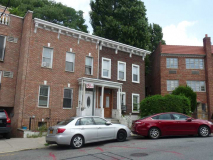
ONE of Queens’ best-kept secrets can be accessed via a driveway at 35th Avenue at 71st Street between an animal hospital and a Chinese restaurant. Walk right in past a selection of garages and back doors to businesses on 35th Avenue up to a mural depicting a young woman holding a miniature planet earth, and walk up to the gate which is festooned with yellow ribbons, and peer inside.
This is the ancient burial ground of the Leverich family. William Leverich emigrated to Newtown in 1663 from England and the burial ground was once part of the settlement belonging to his son Caleb. He built his homestead in 1670 and it stood until 1909. Though headstones were recorded by historian James Riker in the 1890s, all of them have disappeared by now and the cemetery has not accepted any burials since 1870, the Leverich family having dispersed decades ago. The name is still prominent on this 1909 Queens map of the Jackson Heights area, however.
Thomas Leverich, a family descendant living in Connecticut, researched and wrote a lengthy treatise on the burial ground’s history. The New York City Cemetery Project has more information and maps.
After years as a dumping ground, the Jackson Heights Beautification Group has cleaned up the space of debris and planted the flowers and flora you see there today.
Leverich Cemetery is not the only remnant of the former tenancy of the Leverich family in these parts. A short street, Leverich Street, angles southeast between 35th Avenue and 35th Road. There are a few buildings on the street that appear to be older than the rest, along with an apartment building named for Andrew Jackson…for whom Jackson Heights is not named. Instead, Jackson Heights is named for the man who built Northern Boulevard.
Northern Boulevard was built in 1859, and opened to traffic in 1860, between what is now Vernon Boulevard and the Flushing River by the Hunter’s Point, Newtown and Flushing Turnpike Company. It connected to roads further east past the Flushing River, but the newly built stretch was named Jackson Avenue for the turnpike company’s construction supervisor, John C. Jackson. By 1920, most of the road had been renamed Northern Boulevard, with the westernmost section between Vernon Boulevard and Queens Plaza retaining the old name.
As always, “comment…as you see fit.” I earn a small payment when you click on any ad on the site.
8/30/23






10 comments
Since the headstones have all disappeared they must have been repurposed
for other uses.Can anyone name a few?
It’s more likely that the headstones — like those in many old cemeteries — were simply destroyed by bored kids over the years. Many graves in Green-wood, for example, have suffered that fate. Sixteen of my relatives were buried there between 1860 and 1906, mainly in the “cheap seats” near the perimeter fence. All of them once had headstones, which magically “disappeared” by the mid-1970s.
Check out Socrates Park where stones from a local cemetary were repurposed. There are tons of uses for repurposed blocks of marble, slate or limestone – look it up and see for yourself!
Remember going back there and seeing back yards and no evidence. The NY Cemetary Project has a nice article about the family and their cemetary.
I think the driveway is between 70th and 71st, not 75th.
When visiting friends in Rhode Island , who lived in a circa 1740’s house, they showed me the remains of a cemetery from the 1690’s on. And , also across an ancient stone wall, a new housing development. And mixed in with the slate stones on the patio s were old grave stones from the cemetery. As in great country America.
Hell,in Miami theyre already digging corpses up to use the remains in
“religious” rituals.All that remained of this one guy’s vault was a pair
of pants and a belt.
Many of the old gravestones disappeared, knocked down by order of the cemetery officials, so the gardeners could cut the grass without encumbrances.
In the 1960’s Temple University bought a disused cemetery in Philadelphia for a campus expansion and relocated the bodies to a different cemetery. If family members could be located it also moved the gravestones. If they couldn’t, as usually was the case, Temple provided simple plaques for the relocated graves and dumped the old gravestones along the banks of the Delaware River to prevent erosion.
Went by there in spring, and looked through gate. A woman approached us and wanted to know if we wanted to go inside. Apparently maintained by a few neighboring volunteers. Very well cared for when we went.
Played as a kid in that alley across from 71st st , (between animal hospital and back then cleaners?) which continued up the hill to a fence for an apartment house, late 50’s through mid 60’s There was no evidence whatsoever of a cemetery but interesting enough, we (somehow) believed that there were dead bodies buried behind the row of garages which existed on right side and used to dig for bones. I do not recognize the clearing in your top photo. No such open space existed then. Just an asphalt road with garages on the right. Behind them gardens for the houses on leverich st. Oh just went into Google Maps, all the garages I knew were taken down and maybe moved and it all looks way more wide open. Almost motivates me to go back for a visit.